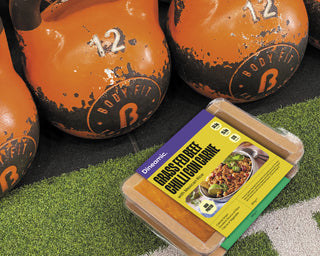
Now that winter has officially arrived, getting enough of the sunshine vitamin (a.k.a. Vitamin D) into your system has become just that bit more difficult. And with approximately 30% of Aussie adults living with a mild to moderate Vitamin D deficiency, we thought it was the perfect time to ask what we do to stay sun-safe and still get the vitamin D fix our body needs to stay healthy? And what impact (if any) have our increasing sun-safe habits had on our vitamin D levels?
What is Vitamin D?
 First things first, let’s look at what it actually is!
First things first, let’s look at what it actually is!
Vitamin D, scientifically known as “cholecalciferol” (rolls off the tongue doesn’t it) is a fat-soluble vitamin and pre-hormone that comes in two forms; one from sunlight (D3) and one from our diet (D2). It plays an important role in increasing absorption of Calcium & Phosphorus both of which are vital minerals for bone strength and muscle function1. Healthy levels of vitamin D have also been shown to boost your immune health and help protect against colds & flu – two things we all want to avoid in winter!
Diet & Fortification
It is difficult to find enough dietary sources of vitamin D in our food supply, with it almost impossible to get a sufficient amount from food alone2. But it’s important to know it can help reach and maintain the levels that your body needs so that you’re not only relying on the sun and supplements
Some of the best food sources of Vitamin D include3:
- Fish sources (e.g. salmon, canned tuna, sardines, cod liver oil)
- Egg yolks
- Mushrooms exposed to sunlight
- And Australian margarine or milk fortified with Vitamin D.
Interestingly, mushrooms produce vitamin D after being exposed to UV light, so why not bathe your mushrooms in sunshine while you get some rays yourself!
This is a great way for those who follow a vegetarian or vegan diet to boost their dietary intake of vitamin D as there are limited suitable sources as most are animal- based4.

Sun Exposure
 Sunlight differs depending on so many things - where you are, the season, time of the day and how cloudy it is. And if you’re in Melbourne like us, let’s be real, this can change about 6 times throughout the day.
Sunlight differs depending on so many things - where you are, the season, time of the day and how cloudy it is. And if you’re in Melbourne like us, let’s be real, this can change about 6 times throughout the day.
A great rule of thumb is when the weather report shows a UV index of “3” head outside, spend a few minutes outdoors a few times a week6. Keep in mind, this will usually be in summer, so we recommended heading out during the mid-morning to mid-afternoon (which is just outside the peak UV levels). Remember to also keep a balance between safe sun time and vitamin D absorption so sunscreen, hats and covering up to a degree is still needed.
As for the Winter time, the UV index will most likely be below 3, but if you catch a glimpse of sunlight (usually around midday) be sure to head outside – take off those ten layers (as hard as that sounds), roll up those sleeves and get a good 2- 3 hours of time out in the sun spread throughout the week.
Keep in mind that everyone absorbs Vitamin D differently, which means there is no set value of how much sun exposure is needed in minutes.
Check out some of the factors that can impact whether you need more sun or less below:
More sun exposure is often required by:
- Those with naturally darker skin colour as melanin (pigment in the skin) doesn’t absorb vitamin D as effectively as fairer skin
- Those who cover their skin for religious or cultural reasons
- People who mostly indoors including the elderly
- Individuals who are already deficient
- Those taking certain medications that can affect calcium and vitamin D absorption
- Those who already avoid sun exposure & may not be getting enough
Less sun exposure in often required by
- Those who live in the northern areas of Australia and are exposed for longer periods of day
- Those that have higher exposure due to their work environment (e.g. machinery operators and drivers).

Vitamin D Paradox
The harsh Australian sun puts us in a tricky spot… we know that too much sun exposure can cause skin cancer, sunburns and eye damage but could our concern and sun safe habits (like covering up our skin, wearing sunscreen, or not going out in the sun too much) have improved dramatically in the last decade. But is this what has led to approximately 30% of Aussie adults living with a mild to moderate Vitamin D deficiency7.
Norval & Wulf (2009)8, reviewed the presented paradox and found that although sunscreen use and our sun smart ways reduced the production of vitamin D in controlled settings, this was not at a dosage high enough to lead to vitamin D deficiency. So keep up your sun safe habits team!
We know it can be tricky in winter to get your vitamin D, but by factoring some sunshine when you can, and a few vitamin D rich foods then you should be able to maintain healthy levels which will help you stay fighting fit! Of course, if you’re ever worried about being low in Vitamin D it’s always a good idea to have a chat to a health professional or your local GP. Now go out and get some rays!
References:
- Nutrient Reference Values for Australia and New Zealand. Factsheet Vitamin D - https://www.nrv.gov.au/nutrients/vitamin-d
- Fuller K, Casparian J. Vitamin D: balancing cutaneous and systemic considerations. Southern Med J 2001;94:58-64.
- Gibson RS, 2005, Principles of Nutritional Assessment, 2nd edition, Oxford University Press, New York.
- Koyyalamudi SR, Jeong SC, Song CH, Cho KY, Pang G. Vitamin D2 formation and bioavailability from Agaricus bisporus button mushrooms treated with ultraviolet irradiation. J Agricultural & Food Chemistry 2009; 57: 3351-3355
- Horticulture Innovation Australia. Australian Mushrooms. Health & Nutrition Vitamin D. https://www.australianmushrooms.com.au/vitamin-d/
- Cancer Council. Sun Safety. Vitamin D. https://www.cancer.org.au/preventing-cancer/sun-protection/vitamin-d/
- Australian Bureau of Statistics. Australian Health Survey: Biomedical Results for Nutrients, 2011-12. Feature Article: Vitamin D. http://www.abs.gov.au/ausstats/abs@.nsf/Lookup/4364.0.55.006Chapter2002011-12
- Norval & Wulf. Does chronic sunscreen use reduce vitamin D production to insufficient levels? British Journal of Dermatology 2009;161:4, 732-736










